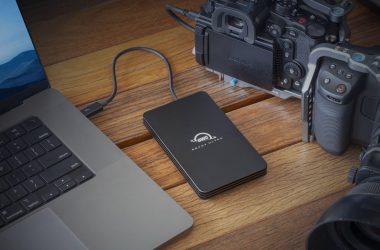The ultimate guide to the best Thunderbolt 3 audio interface to maximize your music production.
If you’re a music producer, DJ, or looking for professional audio performance from your computer, you need more powerful hardware than the built-in sound card in your PC. Audio interfaces improve the sonic capabilities of a computer and let you connect different music appliances such as microphones, keyboards, guitars, and other kinds of signals.
In this article, we review the best audio interfaces in the market that support Thunderbolt 3.
Table of Contents
Why Thunderbolt 3 Audio Interface?
Audio interfaces connect to your computer using standard USB ports, Firewire, PCI, or even PCMCIA slots. However, some of the connectivity slots are quickly becoming obsolete as new protocols hit the market. The new MacBook only ship with Thunderbolt 3 ports, which means you cannot connect audio interfaces with Firewire or legacy USB ports unless you are ready to spend on dongles.
Like any Thunderbolt 3 device, you can daisy-chain up to six Tb3 audio interfaces for superior recording, mixing, and music production. Tb3 is the perfect option for sound engineers who are looking for crystal clear sound quality and minimal latency during the recording and production process.
Choosing a Thunderbolt 3 Audio Interface
Audio interfaces aren’t the same. Depending on the needs of your production workspace, there are specific features that you should consider to get the best from the tb3 audio interface. What’s important is to first determine the use of the audio interface to prevent paying for premium features that you don’t need in your studio.
Number of inputs/outputs
The number of inputs and outputs depends on the kind of work you’re going to use with the audio interface. If you’re going to record audio with multiple professional microphones, you need an audio interface with more than one XLR microphone inputs. However, for recording voice-overs, a single XLR input should be enough.
Besides XLR inputs, tools such as keyboards connect to your audio interface using line-level TRS inputs. Line level inputs are desirable than XLR mic inputs because they’re good at rejecting noise and don’t need amplification to get excellent sound quality. Microphones, on the other hand, output weak signals; as such, you will need an audio interface with onboard preamplifiers to boost the signal for superior sound quality.
For DJs and game developers, the number of line-level outputs is very significant in the production process. Always select an audio interface with at least four line-level outputs for deejaying. With this, you can use two outputs for your stereo speakers and two outputs to connect headsets for cueing songs.
Surround sound is critical in gaming. When producing audio for video games, you need up to eight outputs to achieve a real 7.1 surround sound setup. With this, you can connect seven surround sound speakers and a subwoofer, or settle for 5.1 surround sound if the audio interface provides up to line level outputs.
Please note that the more inputs you have, the more electronic types of equipment you can use simultaneously. Multiple mic-level slots allow you to record using several mics, in case of a band, and numerous line-level inputs let you connect different equipment such as mixing desks, CD/DVD players, synthesizers, and preamplifiers.
Phantom Power and Why It’s Important
There are different kinds of mics available. Some operate without power, while others rely on batteries and electricity from the host to pick up sound. Phantom power is the power from audio interfaces that mics rely on to record sound. Therefore, if you have mics that require electricity to operate, choose an audio interface that supports phantom power (48V PH Power).
Thunderbolt 3 Audio Interfaces Compared
| Image | Product | Details | Check Price |
|---|---|---|---|
 | Universal Audio Apollo Twin X QUAD Heritage Edition | Form factor: Desktop I/O channels: 10 Input / 6 Output Audio resolution: 24-bit/192kHz Mic preamps: 2 Built-in DSP: Yes, 4 Cores Included Software: LUNA Recording System (Mac only), Apollo Console OS: macOS and Windows 10 or later | Check on Amazon |
 | Universal Audio Apollo x8p Heritage Edition | Form factor: Rackmount I/O channels: 16 Input / 22 Output Audio resolution: 24-bit/192kHz Mic preamps: 8 Built-in DSP: Yes, 6 Cores Included Software: LUNA Recording System (Mac only), Apollo Console OS: macOS and Windows 10 or later | Check on Amazon |
 | PreSonus Quantum 2626 - Best Value Thunderbolt Audio Interface | Form factor: Rackmount I/O channels: 26 Input / 26 Output Audio resolution: 24-bit/192kHz Mic preamps: 8 Built-in DSP: No Included Software: Studio One Artist, Studio Magic software, Ableton Live Lite OS: macOS, Windows 10 or later | Check on Amazon |
 | Universal Audio Apollo Solo Heritage Edition | Form factor: Desktop I/O channels: 2 Input / 4 Output Audio resolution: 24-bit/192kHz Mic preamps: 1 Built-in DSP: Yes, 1 Core Included Software: LUNA Recording System (Mac only), Apollo Console OS: macOS and Windows 10 or later | Check on Amazon |
 | Antelope Audio Zen Q Synergy Core | Form factor: Desktop I/O channels: 14 Input / 10 Output Audio resolution: 24-bit/192kHz Mic preamps: 2 Built-in DSP: Yes, 2 Cores Included Software: No OS: macOS and Windows | Check on Amazon |
 | Antelope Audio Zen Tour Synergy Core | Form factor: Desktop I/O channels: 18 Input / 26 Output Audio resolution: 24-bit/192kHz Mic preamps: 4 Built-in DSP: Yes, four Cores Included Software: No OS: macOS and Windows | Check on Amazon |
1. Universal Audio Apollo Twin X QUAD Heritage Edition – Best Thunderbolt 3 Audio Interface Overall
Universal Audio has a rich heritage of producing studio-grade audio interfaces and preamps, and its Apollo Twin X QUAD Heritage Edition may be just the perfect audio interface you can buy for your home studio. It’s a 10×6 desktop interface with 24-bit/192kHz capabilities and a Thunderbolt 3 connection for Mac and Windows PCs.
The Apollo Twin X QUAD Heritage Edition is well built with tough and durable materials. It has all the controls on the front panel, including a talkback mic, 48V phantom power, a high-pass filter, mute, alternative speakers, and more. The talkback feature makes it easy to talk to the artist without having to move around the room.
This model has four SHARC DSP processing cores that deliver plenty of DSP power for running multiple UAD plugins in real-time. The Apollo Twin X QUAD Heritage Edition comes with a collection of UAD plugins, including compressors, amp modelers, preamps, and more, to easily get you started. You also get the LUNA software, a low-latency and fully-integrated DAW for Mac.
As for I/O, this interface supports ten inputs and six outputs simultaneously. It has two mic/line inputs, one Hi-Z input for guitars, and an optical input that allows for up to eight channels. The mic and Hi-Z inputs are all Unison-enabled, meaning you can load Unison plugins to get that classic sound of vintage mic preamps or guitar amps. Output is taken care of by two line outputs, two dedicated monitor outputs, and a stereo headphone output.
Overall, if you’re looking for a proven and professional desktop audio interface to upgrade your studio, the Apollo Twin X QUAD is an excellent option. These are top-of-the-line interfaces used by world-renowned producers and professional studios. However, if you don’t work with a lot of plugins, the Apollo Twin X DUO will give the same performance and speed for a lot less.
Our Take
The Universal Audio Apollo Twin X QUAD Heritage Edition is an excellent Thunderbolt 3 interface that combines a compact desktop format with professional standard A/D conversion and plenty of DSP power to run multiple instances of the top of the line UAD plugins.
- Near-zero latency tracking
- Incredible audio quality
- Superb UAD plugins
- Flexible I/O
- No Thunderbolt 3 cable included
- Expensive
2. Universal Audio Apollo x8p Heritage Edition – Premium Thunderbolt 3 Interface
The Universal Audio Apollo x8p Heritage Edition is a rack-mountable Thunderbolt 3 interface designed for professional producers and audio engineers. It features high-quality 24-bit/192 kHz conversion and simultaneous 18 input and 22 outputs, including eight Unison-enabled mic preamps.
Like the Apollo Twin X, the standing-out feature here is the Unison technology that lets you add virtual preamps such as Neve, API, SSL, Helios, Manley, and more into the Apollo Console in real-time, just like having a real preamp in the studio. All of the processing is done inside the interface, so it does not use any of your computer resources. Thanks to its six DSP chips, the Audio Apollo x8p can run more than 20 instances of UAD plugins.
The Audio Apollo x8p Heritage Edition comes bundled with a lot of UAD plugins, including Teletronix LA‐2A, UA 1176LN, Fairchild 670, UA 610‐B, and Pultec EQP‐1A. You also get the LUNA DAW and Apollo Console software for real-time UAD plugins processing, mixing, and routing.
This interface provides other excellent features such as 7.1 surround sound and a talkback mic that can benefit huge recording studios. With two Thunderbolt 3 ports, you can daisy-chain up to four Apollo interfaces to get more DSP power and I/O to meet the growing demands of your studio. Overall, the Universal Audio Apollo x8p Heritage Edition isn’t on this list because of its brand name but because it offers everything you need for professional tracks and mixes.
Our Take
The Universal Audio Apollo x8p Heritage Edition packs even more I/O, more DSP processing power, professional-class converters, and high-quality plugins, making it the best Thunderbolt 3 audio interface for large recording studios.
- Professional-level audio quality
- Near-zero latency tracking
- Incredible performance and plenty of I/O
- Genuine and high-quality mic preamps
- 7.1 surround sound and talkback support
- Included plugins and recording software
- No Thunderbolt 3 cable included
- Expensive
3. PreSonus Quantum 2626 – Best Value Thunderbolt Audio Interface
The PreSonus Quantum 2626 is an affordable Thunderbolt 3 interface with professional standard 24-bit/192 kHz capabilities. It offers Thunderbolt 3 support and flexible I/O up to 26 inputs and 26 outputs along with high-quality converters and preamps at an unbeatable price.
Universal Audio interfaces are expensive, mainly because of the onboard plugins. The PreSonus Quantum 2626 audio interface has a lower price tag yet provides a lot of input and output slots, a fully-featured recording software (the Studio One), and a complete Studio Magic Plug-in Suite.
The PreSonus Quantum 2626 features a rackmount form factor, occupying 1U of rack space. Unlike the Apollos, this audio interface doesn’t have metering capabilities; instead, the front panel houses eight pristine XMAX mic preamps, headphone slots, and several controls. Two of the mic preamps are a combination of XLR mic and Hi-Z connectors, while the other six are mic/line combos. The back panel provides access to even more I/O to connect your instruments and output devices.
PreSonus Quantum 2626 is the only Thunderbolt 3 audio interface that comes with MIDI input and output ports, which lets you connect an old-school controller, synth module, or any compatible hardware.
PreSonus Quantum 2626 has outstanding speeds and ultra-lower (less than 1ms) latency without compromising the audio quality. Whether you’re tracking using monitor speakers or headphones, you can hear voice instantly thanks to the blazing speed and fast tb3 bandwidth.
The sound quality is impressive with low jitter and near-zero distortion, providing crisp and pristine audio quality for hit records. PreSonus Quantum 2626 operates up to 192kHz for high definition mixing and recording, while 115dB dynamic range ensures you capture everything to create a smooth and natural sound with no artifacts.
While it may not feature excellent plugin suites like the Apollos, the sound quality in this audio interface is top-notch, rivaling the high-end options in the market. It is among the fastest audio interfaces in the market, with incredible less than 1ms latency. This medium-priced audio interface beats the premium ones in the market, and it delivers excellent value if you are ready to ditch the free UAD plugin bundles in the Apollos.
Our Take
PreSonus Quantum 2626 delivers superior sonics and premium features that will otherwise cost you more in a Universal Audio interface. The choice of I/O is impressive with an additional MIDI input and output, which is unavailable in most Thunderbolt 3 audio interfaces.
- Incredibly low-latency performance
- Includes talkback mic
- Controlled mic preamps
- Support Thunderbolt daisy-chaining up to four Quantum audio interfaces
- Versatile selection of ports
- Include MIDI I/O
- No built-in DSP. Your computer does all the processing, so make sure to pair it with a powerful PC.
4. Universal Audio Apollo Solo Heritage Edition – Most Portable Thunderbolt 3 Audio Interface
The Universal Audio Apollo Solo (Heritage Edition) is an excellent option for those looking for a portable Thunderbolt 3 audio interface. It’s a simple 2×4 desktop interface with all the latest Apollo features, such as 24-bit/192 kHz audio conversion and real-time UAD processing. The interface is very compact and light, making it easy to grab and go.
The Apollo Solo is bus-powered, meaning it can draw power from the computer it’s connected to, so you don’t need to lug a heavy power brick around. This makes it easy to carry the interface and record tracks just about anywhere.
You have all the controls on the front panel, including a Hi-Z input mainly for guitars and a headphone output. The Thunderbolt 3 port at the back connects the interface to your computer, and you’ll also find two Line outputs and two Unison-enabled mic/line inputs. While there are three inputs in total, you can only use two at a time.
The Apollo Solo features the class-leading converters found on premium interfaces from Universal Audio. You can load genuine amp emulations from Neve, API, Fender, and more using Unison technology, but you’ll be limited to a few instances since the Solo comes with only one DSP core. Regardless, the Solo works excellent with whatever plugin or effect you load into the DSP.
Our Take
The Universal Audio Apollo Solo Heritage Edition delivers high-quality and professional standard recordings on the go. The fact that it does not require external power makes it easy to take on the go.
- Portable and rugged all-metal design
- Excellent audio quality
- High-quality plugins
- Runs a few plugins due to one DSP core
5. Antelope Audio Zen Q Synergy Core – Bus-Powered Thunderbolt 3 Interface with Plenty of I/O
The Antelope Audio Zen Q Synergy Core is another bus-powered audio interface with a Thunderbolt 3 connection. It’s a 14×10 desktop interface, meaning you’re getting plenty of I/O here compared to the Universal Audio Apollo Solo. If you want to record and monitor multiple voices and instruments on the go, the Zen Q Synergy Core from Antelope Audio is the ideal choice.
The Zen Q Synergy Core offers up to 14 inputs and ten outputs, including two mic/line inputs with preamps, two Hi-Z inputs, digital expandable ADAT input (up to eight channels), stereo monitor outputs, two line outputs, and two stereo headphone outputs. That’s an excellent set of I/O that can record a small to medium band in the studio or any on-location recording session.
This interface supports class-leading 24-bit/192kHz conversion, real-time effects processing, and real-time emulations of vintage mic preamps. The sound quality on this thing is fantastic, and the plugins are of high quality. It has built-in DSP cores that take care of all the processing work, freeing up your computer to handle other processing needs.
Antelope Audio offers Zen Q Synergy Core with a standard USB connection. It adds a bit of latency, but you’ll get most of the features and performance for a lot less money.
Our Take
Antelope Audio Zen Q Synergy Core is an excellent Thunderbolt audio interface that provides plenty of I/O, high-quality preamps and converters, and a suite of plugins for professional-level recording in the studio or any location.
- Good range of I/O
- Pristine preamps
- Real-time plugin processing (37 plugins included)
- No dedicated power source required
- Built-in DSP
- Thunderbolt cable is not included
- No talkback mic
6. Antelope Audio Zen Tour Synergy Core – Signature Antelope Sound with Flexible I/O
The Antelope Audio Zen Tour Synergy Core is a desktop upgrade to the Zen Q Synergy Core bus-powered interface, bringing even more I/O and more DSP power to handle the real-time processing of multiple plugins. Antelope Audio claims this interface can handle up to 256 plugins simultaneously, made possible by the four built-in DSP chips and two FPGA chips.
The Zen Tour Synergy Core offers 16/22 simultaneously I/O, including four mic/line preamp inputs, four Hi-Z instrument inputs, two reamp outs, and dedicated stereo monitor output. You can expand the I/O using the ADAT & S/PDIF ports. The front panel has all the controls and knobs, including a talkback feature to communicate with artists in another room easily.
The Zen Tour Synergy Core delivers signature Antelope sound with no artefacts and near-zero latency. You can record, mix, and playback high-resolution audio up to 24-bit/192kHz. The interface comes bundled with 37 real-time plugins, including preamps, equalizers, compressors, and reverbs. Overall, the Zen Tour Synergy Core is one of the most powerful desktop interfaces, with features and sonic quality to rival some of the best rackmount interfaces in the market.
Our Take
The Antelope Audio Zen Tour Synergy Core is an expensive desktop interface, but it provides all the I/O you need with plenty of DSP power, 37 plugins, and ultra-low latency Thunderbolt 3 connection. It’s a powerful desktop interface for professional-grade recording studios.
- Crystal clear discrete mic preamps
- Flexible and expandable I/O, including reamp outs
- Onboard DSP with four cores
- Built-in talkback mic
- Compact desktop footprint
- On the expensive side





